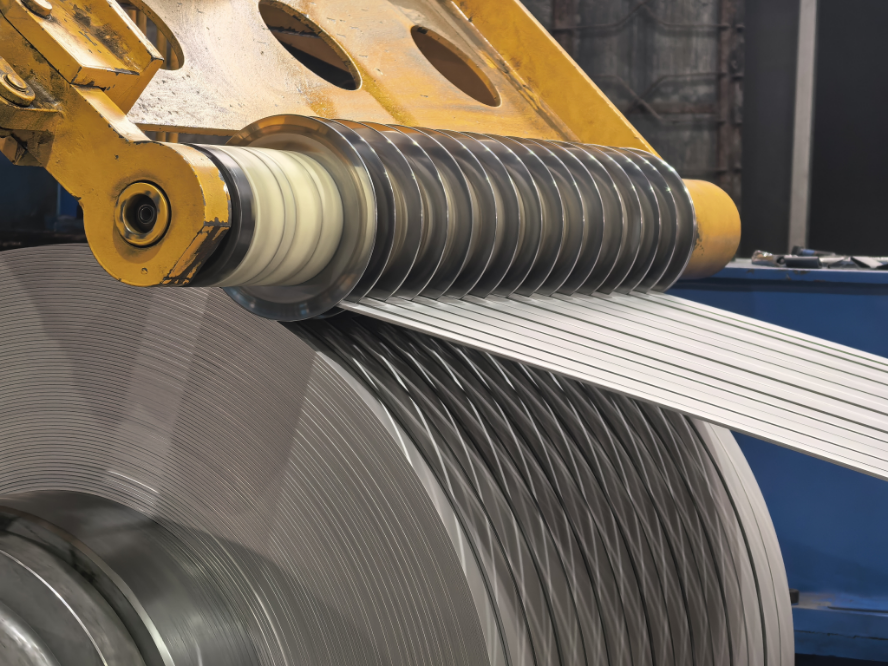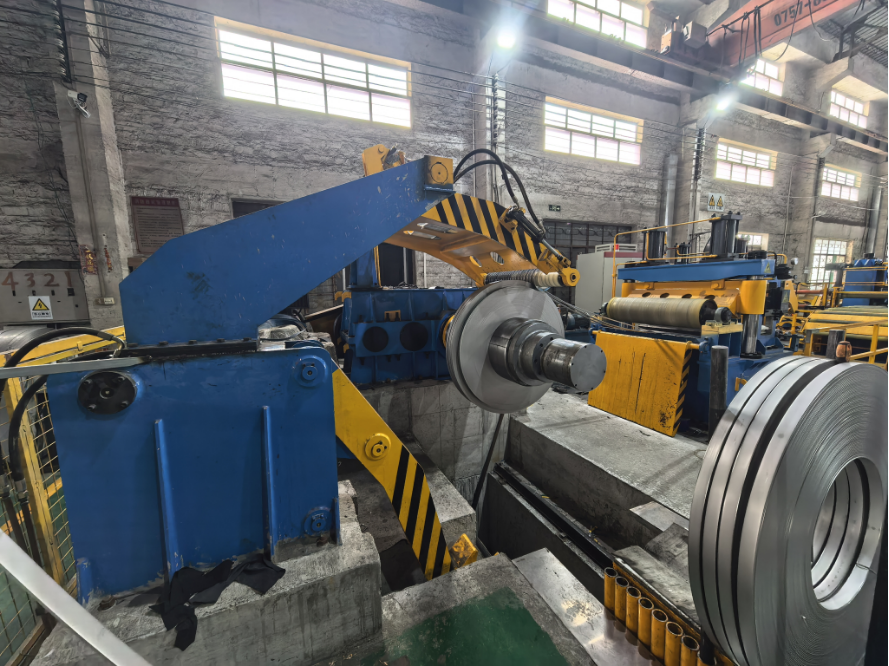What is a Heavy Gauge Cut To Length Line and How Does It Work?
A Heavy Gauge Cut To Length Line is a special machine.It changes thick metal coils into flat sheets or plates. This machine can cut steel up to 1 inch thick.Some machines can also cut thinner steel, down to 0.06 inch. Many industries use these machines to make metal pieces the right size. They need these pieces for making other things or for selling.
- Shipbuilding, heavy machinery, and steel structure building need these strong machines.
- Some machines have computer-controlled levelers and very sharp shears. These features help make sure the cuts are always right and even.
Key Takeaways
- A Heavy Gauge Cut To Length Line changes thick steel coils into flat sheets. It does this with high accuracy. It can handle steel that is up to 1 inch thick.
- The line uses strong machines. These include uncoilers, levelers, shears, and stackers. The machines work together to make flat and precise sheets. They do this job quickly and well.
- Automation and smart controls help the line go faster. They also help lower mistakes. These features keep workers safe by reducing manual work.
- This machine helps make more sheets in less time. It cuts many sheets fast. It makes steel sheets that are smooth and the right size.
- Shipbuilding, heavy machinery, and construction use these lines. They need strong and flat steel sheets for hard jobs.
Components
A Heavy Gauge Cut To Length Line uses many strong machines. These machines help turn thick steel coils into flat sheets. Each part is important for making the steel flat and even.
Uncoiler
The uncoiler holds the steel coil and unwinds it. It can hold very heavy coils, up to 30 tons. The uncoiler moves the steel at a steady speed. Many uncoilers have two mandrels and special brakes. This helps keep the coil steady and saves energy. Some uncoilers load coils by themselves. This means workers do not have to do as much. It also makes the job safer.
Note: The uncoiler can hold coils up to 2100 mm wide and 2000 mm in diameter. Its strong frame and smart controls stop the coil from slipping. This helps the steel feed smoothly.
Leveler
The leveler makes the steel flat after it comes off the coil. Thick steel can have bends or waves from before. The leveler uses heavy rollers to press the steel flat. Some lines use a stretcher leveler for better results. This machine pulls the steel to take out stress and memory. The sheets become very flat. Some levelers open quickly and have dust collectors. This makes them easy to clean and fix.
- Levelers can work with steel from 2 mm to 12.5 mm thick.
- They can make the steel flat within ±1.5 mm for every meter.
- Some use SUREGRIP® technology to stop slipping and make better sheets.
Shear
The shear cuts the steel to the right length. It uses a strong blade for straight, clean cuts. Hydraulic shears are very accurate and fast. Some shears let you change blades quickly. This saves time when you need a new blade.
The shear is very strong. It can cut thick steel without losing accuracy.
Stacker
The stacker puts the cut sheets into neat piles. This makes it easy to move and store the sheets. Many stackers work by themselves and can switch pallets without stopping. Fast drop stackers save money and make the job safer. Some use two palletizers to work even faster.
- Stackers help the line run smoothly by using less manual work.
- They can handle big, heavy sheets and keep them flat and safe.
A Heavy Gauge Cut To Length Line needs all these machines to work together. Each part must be strong to handle thick steel and work for many hours. Smart controls and strong frames help the line make flat, accurate sheets for tough jobs.
Operation
Process Steps
A Heavy Gauge Cut To Length Line follows a clear process to turn thick metal coils into flat sheets. Each step plays a key role in making sure the sheets are flat and the right size.
- Uncoiling
The line starts by placing a heavy steel coil onto the uncoiler. The uncoiler unwinds the coil, removing the natural curve from the metal. This step begins the flattening process and prepares the material for the next stage. - Leveling
The metal moves into the leveler. Heavy rollers press and stretch the steel, taking out any bends or waves. Some lines use a stretcher leveler for even better results. Leveling ensures the sheet is flat before cutting. - Corrective Leveling
If the steel still has small bends, the line may use corrective leveling. This step uses special rollers or tension to remove the last bit of curve. Studies in metal forming show that leveling and corrective leveling are critical for flatness and shape control. - Shearing
The shear cuts the flat steel to the right length. The blade moves quickly and accurately, making sure each sheet matches the set size. This step guarantees dimensional accuracy. - Stacking
The stacker collects the cut sheets and places them in neat piles. This keeps the sheets flat and makes them easy to move. Stacking also protects the sheets from damage.
Tip: Each step in this process helps keep the sheets flat and the sizes correct. Industries like automotive and aerospace use these lines because they need high-precision metal sheets.

Heavy Gauge Cut To Length Line
Quality Control
Quality control is very important in a Heavy Gauge Cut To Length Line. The line uses several checks to make sure every sheet meets strict standards.
- Operators check for burrs, cracks, and distortions. These defects can affect how the sheet fits and looks.
- The line measures each sheet to make sure it matches the set size. Standards like ISO 2768-1:1989 guide these checks for length, width, and angles.
- Workers verify the material type, thickness, and finish. This ensures the sheet will last and perform well.
- The line follows international standards such as ISO and ASTM. Meeting these standards helps the sheets work in many industries.
- Quality control teams use calibrated tools and trained staff. This helps catch problems early and keeps quality high.
Note: Advanced lines use smart systems and sensors to watch the process in real time. These systems help spot problems fast and keep the line running smoothly.
Heavy Gauge Cut To Length Line Operation
Operating a Heavy Gauge Cut To Length Line requires strong machines and careful planning. The line handles very heavy coils and thick steel, often over half an inch thick. Each machine must work together to keep the process safe and efficient.
Operators load the coil onto the uncoiler, making sure it is secure. The line moves the steel through each step, using smart controls to keep the speed steady. The leveler and shear adjust for different thicknesses and lengths. The stacker handles large, heavy sheets without bending or damaging them.
The line uses reinforced frames and high-capacity stackers to manage the weight. Automation helps reduce manual work and keeps workers safe. The process ensures that each sheet is flat, accurate, and ready for use in tough jobs like shipbuilding or heavy machinery.
Callout: The step-by-step process—uncoiling, leveling, corrective leveling, shearing, and stacking—has proven effective in making flat, precise sheets. Technical studies and industry use show that each step helps achieve the best results for flatness and accuracy.
Features
Material Thickness
A Heavy Gauge Cut To Length Line can handle very thick steel. Many lines process steel up to 16 mm (about 0.63 inch) or more. Some lines work with even thicker plates for special jobs. This ability makes the line useful for industries that need strong, heavy sheets. Shipyards, bridge builders, and heavy equipment makers often choose these lines for their toughest projects. Optional stretcher levelers help remove stress from the steel. These levelers make the sheets even flatter and better for welding or painting.
Tip: Thicker steel needs stronger machines. The line uses heavy rollers and powerful motors to keep the process smooth.
Automation
Modern lines use advanced automation. Computers control the speed, pressure, and cutting length. Operators set the size and thickness on a screen. The line then adjusts itself for each job. Sensors watch the steel as it moves through the line. If the steel moves out of place, the system makes quick changes. This automation helps the line work faster and with fewer mistakes.
- Automated lines need fewer workers.
- The system can store settings for different jobs.
- Quick changes between jobs save time.
Precision
Precision matters in every sheet. The line uses sensors and smart controls to measure each cut. The shear cuts the steel within a small margin, often better than ±0.5 mm. Levelers and stretcher levelers help keep the sheets flat and true. This high precision means the sheets fit together well in later steps. Builders and manufacturers trust these lines for their accuracy.
Safety
Safety stands as a top priority. The line uses guards and sensors to protect workers. Emergency stops let operators halt the line quickly. Many lines use automatic coil loading and stacking. This reduces the need for workers to handle heavy steel by hand. Training and clear signs help everyone stay safe.
Note: Safety features lower the risk of injury and keep the line running smoothly.

Heavy Gauge Cut To Length Line
Benefits
Productivity
A Heavy Gauge Cut To Length Line helps factories work much faster. The machines can cut many sheets from big coils quickly. Workers do not need to move heavy steel by hand as much. Automation lets the line keep running with fewer stops. This helps companies finish large orders in less time. Many lines save job settings in the computer. Operators can change jobs with just a few easy steps.
Tip: Fast production helps companies finish orders on time and help more customers.
Sheet Quality
The line makes flat and smooth sheets every time. Levelers and shears work together to take out bends and waves. Sensors check each sheet for the right size and shape. The finished sheets have smooth edges and even surfaces. Builders and machine makers trust these sheets for their work. Good sheet quality means less waste and fewer problems later.
Flexibility
Factories use the line for many types of steel and sizes. Operators can change the length and width for each order. The line works with thick or thin steel. This flexibility helps companies serve many industries, like shipbuilding or heavy machinery. Some lines have special tools for extra flatness or faster stacking.
- Companies can take new jobs without buying new machines.
- The line fits many production needs.
Note: Flexibility makes the Heavy Gauge Cut To Length Line a smart choice for growing businesses.
Applications
Industries
Many industries use a Heavy Gauge Cut To Length Line to work with thick steel sheets. Shipbuilding companies need these lines to make big, flat plates for ship hulls and decks. Heavy machinery makers use strong, flat steel for frames and parts. Steel structure builders use these sheets for bridges, buildings, and towers. The energy sector uses these lines to get steel ready for wind towers and oil platforms. Railcar and truck makers need flat plates for floors and sides.
- Shipbuilding
- Heavy machinery
- Steel structures
- Energy (wind towers, oil rigs)
- Railcar and truck manufacturing
These industries pick this equipment because it can cut thick, heavy steel very accurately.
Use Cases
A Heavy Gauge Cut To Length Line helps companies make many things. Shipyards cut big plates for ship hulls. Bridge builders use flat sheets for decks and supports. Factories use these lines to get steel ready for cranes and bulldozers. Some companies cut special plates for storage tanks or pressure vessels. The line also helps make steel for building projects, like stadiums and tall buildings.
Comparison with Other Lines
A Heavy Gauge Cut To Length Line is different from other lines. Slitting lines cut coils into thin strips, not flat sheets. Standard cut to length lines work with thinner steel, usually less than half an inch thick. Only a heavy gauge line can cut thick steel plates up to 1 inch or more. The sheets from this line are big, flat, and very exact. These sheets are ready for welding, painting, or putting together. Companies use this line when they need strong, flat, and accurate thick steel.
For thick, heavy steel, no other line works as well as a Heavy Gauge Cut To Length Line.
A Heavy Gauge Cut To Length Line changes thick steel coils into flat sheets. This machine is very strong and works with high accuracy. It uses smart controls to help do the job well. Many companies use it for shipbuilding, big machines, and steel buildings. People who want better production should talk to experts or check what they need before picking a line.
For more information, companies can ask a supplier or go to a factory to watch the line work.
FAQ
What is the main difference between a heavy gauge and a standard cut to length line?
A heavy gauge line can cut much thicker steel. It can cut steel up to 1 inch thick or more. A standard line cuts thinner steel, less than half an inch thick. Heavy gauge lines use stronger machines for hard jobs.
How does automation help in a heavy gauge cut to length line?
Automation runs the machines and checks the steel. It helps the line go faster and makes fewer errors. Operators can change settings with little effort. Automated lines also keep workers safer by using less manual work.
Can one line handle different steel thicknesses?
Yes, most heavy gauge lines can work with many thicknesses. Operators pick the thickness on a control panel. The machines then change their settings to fit the steel. This lets the line do many different jobs.
What safety features do these lines include?
Most lines have guards, sensors, and emergency stops. Automatic loading and stacking mean workers touch heavy steel less. Training and clear signs help keep everyone safe when using the line.

